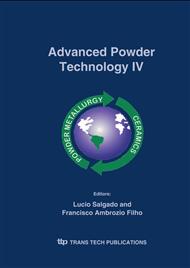p.529
p.535
p.540
p.546
p.552
p.558
p.564
p.569
p.575
Influence of the Granulometry of Organic Matter Ashes from Municipal Solid Waste on the Properties of Vitrified Ceramics
Abstract:
This work studies the influence of the granulometry of organic matter ashes from the municipal solid waste (MOL) on the mechanical properties of vitrified ceramics. Mixtures of clay with additions of the MOL ashes were prepared as vitrified ceramics. The degree of immobilization of the potentially toxic metals (PTM) contained in the ashes was then evaluated. Samples of a sedimentary clay with 13.5% of MOL ashes with granulometry, 35 and 200 mesh, were uniaxially pressed at 18 MPa and sintered at 1200°C. Results from 3- point flexural resistance and water absorption tests showed that the reduction in the particle size of the MOL ashes increased the mechanical resistance to 45 MPa while the water absorption reached 0.8%. These results and the high degree of immobilization of the PTM qualify the ceramic vitrification as an alternative to the final disposal of the MOL.
Info:
Periodical:
Pages:
552-557
Citation:
Online since:
November 2005
Price:
Сopyright:
© 2005 Trans Tech Publications Ltd. All Rights Reserved
Share:
Citation:


